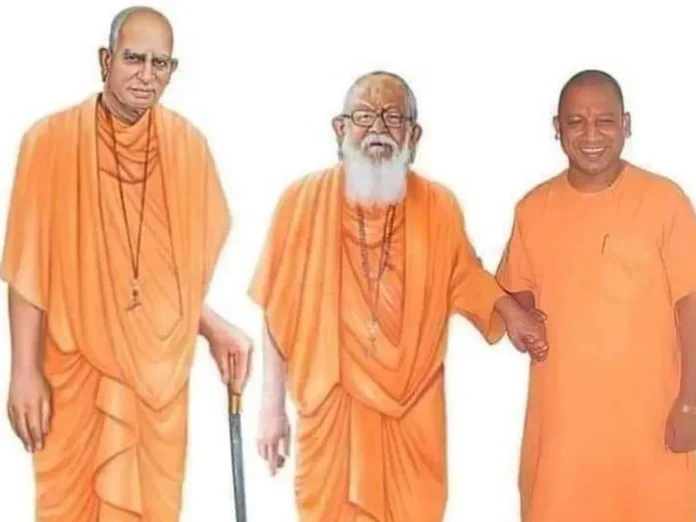Played an pivotal role in accelerating Ayodhya Ram Mandir movement towards decisive ends
Abhyans Singh Rathore
The Ayodhya Ram Mandir movement stands as a defining chapter in India’s history, a fervent call for the construction of a grand temple at the birthplace of Lord Ram. While many prominent figures have dominated the narrative, there are unsung heroes who played pivotal roles, laying the groundwork for the eventual realization of the Ram Mandir. Among these unsung heroes, Mahant Avaidyanath emerges as a towering figure whose contributions to the movement have often been overshadowed. This article sheds light on the life, legacy, and the invaluable role played by Mahant Avaidyanath in the Ayodhya Ram Mandir movement.
Born as Kripa Singh Bisht, Mahant Avaidyanath’s journey towards becoming a spiritual luminary commenced in the lap of the Himalayas. A follower of Mahant Digvijaynath of Gorakshapeeth in Uttar Pradesh, he underwent a profound transformation, adopting the ascetic name Mahant Avaidyanath in 1940. This marked the beginning of his unwavering commitment to the principles of Sanatan Dharma and his dedication to the cause of building a temple at the Ram Janmabhoomi in Ayodhya.
In 1969, Mahant Avaidyanath ascended to the revered position of the head of the Gorakshapeeth, a significant Hindu monastery with a rich history. This position not only affirmed his spiritual authority but also provided him with a platform to influence the socio-religious landscape. His leadership in Gorakshapeeth became a cornerstone for his later involvement in the Ayodhya Ram Mandir movement, laying the foundation for the role he would play in shaping the destiny of the nation.
Mahant Avaidyanath’s influence extended beyond the spiritual realm into the political arena. A member of the Hindu Mahasabha, he actively engaged in political activities, becoming a five-term Member of the Legislative Assembly (MLA) and serving as a four-term Member of Parliament (MP) from Gorakhpur. His dual roles as a spiritual leader and a political representative underscored the seamless integration of religion and politics in his life, a characteristic often seen in leaders shaping the narrative of the Ayodhya Ram Mandir movement.
In the mid-1980s, as the winds of the Ram Mandir movement began to gain momentum, Mahant Avaidyanath assumed crucial organizational responsibilities. He became the first president of the Ramjanmabhoomi Mukti Yagya Samiti, a pivotal institution established to spearhead the movement for the construction of the Ram Temple. His leadership in this committee played a pivotal role in mobilizing support, galvanizing the masses, and providing direction to the movement that had become a potent force in the national discourse.
Additionally, Mahant Avaidyanath served as the president of another influential organization, the Ramjanmabhoomi Nyas Samiti. This organization played a critical role in overseeing the planning and execution of the temple construction. Under his guidance, these organizations became instrumental in channeling the sentiments of millions of Hindus who sought the establishment of a grand Ram Temple in Ayodhya.
Mahant Avaidyanath’s unwavering commitment to the Ayodhya Ram Mandir movement led to his involvement in the Babri Masjid demolition case. Accused as one of the key figures in the demolition, he faced legal scrutiny for his role in the events that unfolded on that fateful day. While the legal proceedings cast a shadow on his legacy, it is essential to understand the nuanced circumstances surrounding the demolition and the complex dynamics that led to those events.
Beyond the political and legal aspects, Mahant Avaidyanath’s contributions to social harmony should not be overlooked. Despite the charged atmosphere surrounding the Ayodhya Ram Mandir movement, he consistently advocated for peaceful coexistence and harmony among communities. His teachings emphasized the inclusive nature of Sanatan Dharma, fostering a spirit of understanding and respect for diverse beliefs.
Mahant Avaidyanath’s legacy extends far beyond the confines of the Ayodhya Ram Mandir movement. His role as an unsung hero reflects not only in the physical manifestation of the temple but also in the intangible impact on the collective consciousness of millions of Indians. The construction of the Ram Temple stands as a testament to the enduring spirit of the people and the relentless efforts of leaders like Mahant Avaidyanath who navigated the complex interplay of spirituality, politics, and social dynamics.
In the annals of the Ayodhya Ram Mandir movement, Mahant Avaidyanath emerges as a towering figure, an unsung hero whose contributions deserve recognition and remembrance. His spiritual journey, leadership in Gorakshapeeth, political engagements, organizational roles, and the challenges faced in the aftermath of the Babri Masjid demolition collectively weave a narrative that goes beyond the confines of any one movement. Mahant Avaidyanath’s life epitomizes the intricate connections between spirituality and sociopolitical realities, showcasing the enduring impact of individuals who dedicate their lives to causes larger than themselves. As the Ram Temple stands tall in Ayodhya, it is essential to acknowledge the multifaceted legacy of Mahant Avaidyanath, an indelible mark on the tapestry of India’s cultural and religious history.


